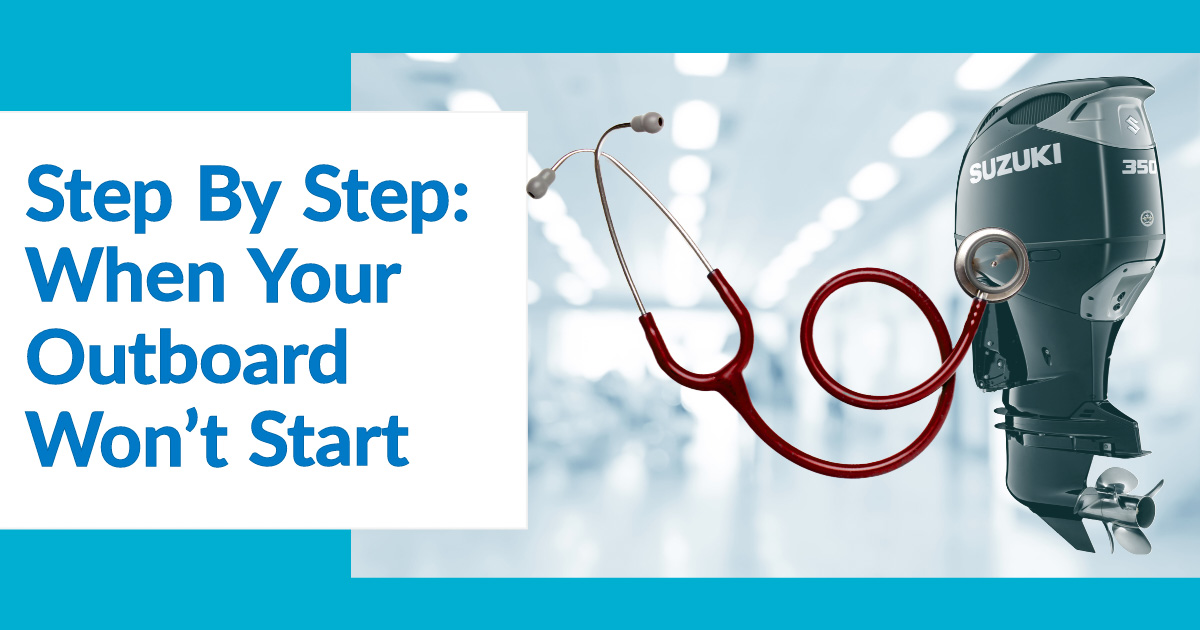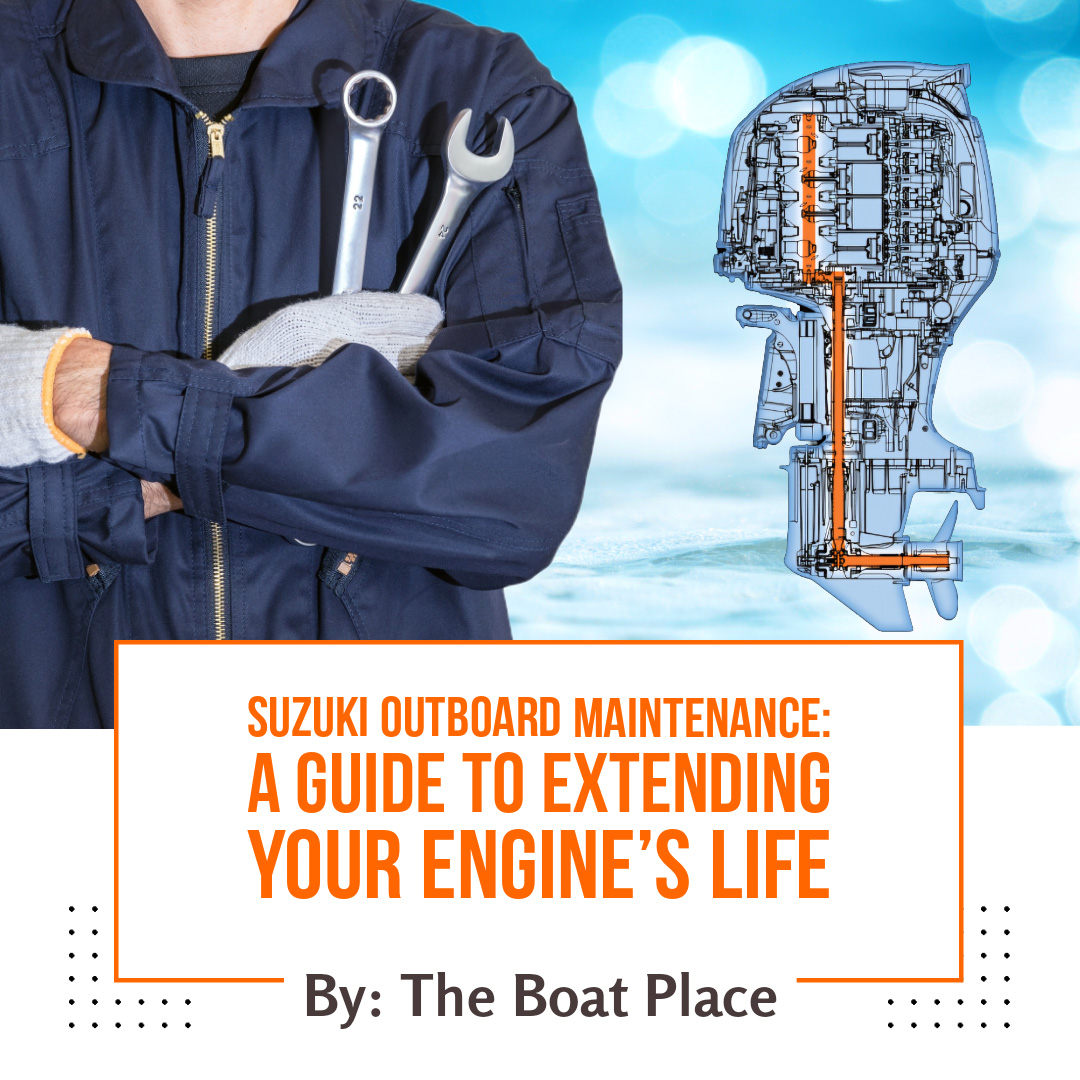
Troubleshooting A Suzuki Outboard That Won’t Start: Step By Step
Having trouble with your Suzuki outboard motor? You’re ready for a day on the water, but your engine disagrees. Here’s a step-by-step guide to identify and possibly fix the issue yourself. If you’re still having trouble, The Boat Place is here to help with expert, factory-trained technicians and a full-service marine shop
Step 1: Check the Battery
Ensure your battery is charged and connections are clean. A weak or dead battery is a common culprit for starting issues. Use a multimeter to check the battery voltage; it should read around 12.6 volts when fully charged. When checking the battery of a Suzuki outboard motor, there are several safety considerations to keep in mind:
Wear Protective Gear: Always wear safety glasses and gloves when working near batteries to protect against possible acid splashes and to avoid direct contact with battery acid.
Check for Corrosion: Before touching the battery, inspect it for signs of corrosion on the terminals. Corrosion can cause poor connections and may also be indicative of a leaking battery. Cleaning corrosion should be done carefully to avoid skin contact with corrosive substances.
Disconnecting the Battery: If you need to remove or replace the battery, always disconnect the negative terminal first to minimize the risk of sparks. When reconnecting, connect the negative terminal last.
Use of Tools: Ensure that any tools used are in good condition and do not have any exposed metal parts that could touch both battery terminals simultaneously, causing a short circuit.
Ventilation: Work in a well-ventilated area to avoid inhaling gases emitted by the battery, especially if it is damaged or charging.
Handling and Stability: Ensure the battery is securely mounted in the boat. When handling the battery, make sure it is stable and secure. Dropping a battery can cause serious injury and potential spills.
Voltage Check: When using a multimeter to check the voltage, ensure that the multimeter is set to the correct setting to avoid damage to the multimeter or battery. Also, ensure that the test leads are applied correctly to the battery terminals — red to positive and black to negative.
Avoid Sparks: Keep sparks, flames, and other sources of ignition away from the battery area. Batteries can emit flammable hydrogen gas, especially when charging.
Step 2: Inspect the Fuel System
The fuel system is crucial for the smooth operation of your outboard motor. Here’s how to thoroughly inspect each component to ensure it’s in good working order:
Fuel Line Inspection:
Location: The fuel line connects the fuel tank to the engine and is usually a flexible hose.
What to Look For: Examine the entire length of the fuel line for any signs of wear, leaks, kinks, or blockages that could restrict fuel flow. Ensure that all connections are tight and secure.
How to Check: Visually inspect for any damage or leaks, and gently bend the hose to check for cracks. Make sure there are no sharp bends that could cause kinks.
Fuel Quality Check:
Importance of Fresh Fuel: Outboard engines perform best with fresh fuel. Over time, fuel can degrade and form varnish or sediments that may clog the fuel system.
What to Do: If the fuel in your tank is more than a month old, consider draining it and refilling with fresh fuel. Always use the correct fuel type as specified by your engine manufacturer.
Primer Bulb Inspection:
Location: The primer bulb is located along the fuel line and is used to draw fuel from the tank to the engine. It’s typically a small, oval-shaped bulb made of rubber.
What to Look For: Check for any cracks or brittleness. The bulb should be firm but not overly hard; a soft or spongy bulb can indicate degradation.
How to Check: Press the bulb with your fingers; it should spring back to its original shape. If it doesn’t, it may need to be replaced.
Step 3: Examine the Spark Plugs
Spark plugs are crucial for the ignition and overall performance of your outboard motor. Here’s a step-by-step guide on how to examine them:
Locating the Spark Plugs:
Where to Find Them: Spark plugs are generally located on the engine head and can be seen as small, cylindrical parts attached to thick wires (these are the spark plug wires).
Accessing Spark Plugs: Depending on the model of your Suzuki outboard, spark plugs might be under a cover or exposed. Refer to your owner’s manual for the exact location and instructions on how to access them.
Inspecting the Spark Plugs:
What to Look For: Check for any obvious signs of wear or damage such as cracked ceramics, burnt electrodes, or heavy carbon build-up.
Condition Indicators:
-
- A grayish-tan color on the electrode indicates a healthy engine.
- Black, sooty deposits might suggest an oil or fuel mixture issue.
- Oily or wet appearance could indicate engine problems like poor oil control.
Tools Needed: You’ll need a spark plug socket and a ratchet or wrench. Optionally, a wire brush or specialized spark plug cleaner can be used to clean the plugs.
Removing and Inspecting:
How to Remove: Attach the spark plug socket to your ratchet and fit it over the spark plug. Turn counterclockwise to loosen. Once loose, carefully remove the spark plug by hand.
Inspecting Tips: Examine the electrode and insulator for any of the conditions mentioned. Measure the gap between the electrodes with a gap gauge tool to ensure it matches the specifications found in your owner’s manual.
Replacing the Spark Plugs:
When to Replace: Replace spark plugs if you notice any of the problem signs mentioned or as part of regular maintenance. Always replace with the type specified in your owner’s manual.
Installation: Insert the new spark plug by hand first to avoid cross-threading, then tighten with the spark plug socket and ratchet. Do not overtighten, as this can damage the threads.
Step 4: Look at the Kill Switch
The kill switch is a safety device designed to stop the engine immediately in case of an emergency. Ensuring it’s in the correct position is crucial for starting your Suzuki outboard motor.
Locating the Kill Switch:
Where to Find It: The kill switch is typically located near the throttle or ignition area on the outboard. It can also be part of the remote control assembly if your motor is operated from a boat’s console.
Appearance: The kill switch usually looks like a red or black plastic clip with a tether attached to it. The tether is meant to be attached to the operator’s wrist or life jacket.
Checking the Kill Switch:
Proper Position: Ensure that the kill switch is in the “Run” position. If the switch is engaged (in the “Off” position), it will prevent the engine from starting.
How to Check: Look for labels or indicators near the switch that show “Run” and “Off” positions. The switch should be set to “Run” for normal operation.
Tether Check: Ensure the tether is securely attached to the switch if your model uses this type of system. Sometimes, the engine won’t start because the tether is not properly connected.
Step 5: Check for Any Error Codes
Many modern Suzuki outboard motors are equipped with digital monitoring systems that display diagnostic error codes. These codes are crucial for identifying issues that are not immediately obvious through physical inspection.
Identifying if Your Outboard Has a Digital Monitor:
Check Your Model Specifications: Reference your owner’s manual or the Suzuki website to determine if your model features a digital monitoring system. Typically, newer or higher-end models include this feature.
Visual Inspection: Look for a digital display panel on your outboard’s control console or near the steering area. The display usually shows engine statistics like speed, fuel levels, and diagnostics.
Models with Digital Monitoring Systems:
Common Models: Higher-end models and recent Suzuki outboard motors, such as those in the DF series (e.g., DF200, DF250, DF300), often include digital monitoring systems. Entry-level models might not include this feature.
Locating and Reading the Digital Monitor:
Where to Find: The digital monitor is typically part of the boat’s main instrument panel or attached separately near the helm. It is usually an LCD or LED screen.
How to Read Error Codes: Power on the monitor and look for any displayed error codes when you attempt to start the engine. The manual for your outboard or digital gauge will have a list of these codes and what they mean.
Action Based on Codes: Once you identify a code, refer to your owner’s manual for specific troubleshooting steps related to that error code. This can guide you on whether the issue is something you can address or if professional help is needed.
Conclusion: When to Call in the Professionals
If the troubleshooting steps outlined in this guide haven’t resolved your Suzuki outboard’s starting issues, it’s time to turn to the experts. At The Boat Place, our factory-trained, Suzuki-certified technicians specialize in handling Suzuki outboards, ensuring that your repairs are done right the first time. Our full-service marine shop is fully equipped to address all your boating needs.
Choosing Suzuki-certified professionals is crucial not only for quality service but also for maintaining your outboard’s warranty. Improper service can void warranties, leading to more headaches down the line. At The Boat Place, we guarantee that our services comply with Suzuki’s standards.
We also offer an exclusive Dock to Shop Vessel Valet Service for added convenience. You don’t need a trailer—simply schedule a pickup at Salty Sam’s Marina or other select locations (please call for details). Trust your boat with the experts who care. Contact us today to schedule your service or to learn more about how we can get you back on the water, hassle-free.
Give us a call or -> Contact Us<- today for the best prices and marine services in Fort Myers
239-415-6400
Thanks For Coming to Our Tide Talk,
~The Boat Place
Suggested & Related Readings:

Learn what to do when your Suzuki Outboard’s oil warning light comes on. This detailed guide provides clear, step-by-step instructions to help get you back on the water

Discover the best gas options for Suzuki outboard motors & learn why REC90 ethanol-free fuel is the choice for performance, longevity, & reduced maintenance


